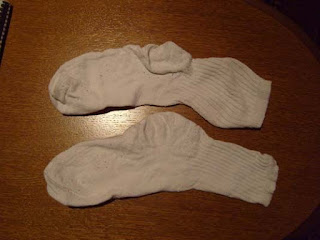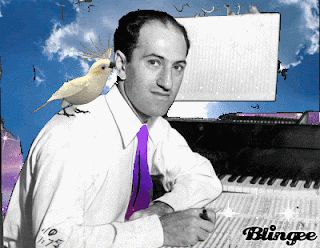I find that early '50s TV ads make the most intriguing gifs. Advertising style was pretty aggressive then, as nobody quite knew how to marry pictures with sound. Announcers intoned in radio-like voices, with that strange theatrical diction from the 1940s that somehow suggests the formal urgency of wartime.
One of the features of these ads is very (VERY) strange animation, much of it primitive or downright incomprehensible. On very early TV shows, credits were written on some sort of material like canvas and pulled along manually, or cards dropped down with a "flop". All this is of great fascination to me, as I have vague memories of some of the later-'50s ones, though as a small child (infant!), I had no real comprehension of them. Ads got a lot more sophisticated in the early '60s, and by mid-to-late they were sort of quirky and self-consciously nutty/hippie-ish in a painful effort to be hip.
Here is one of those offputting animations from Birdseye. Frozen food was still kind of a novelty then, and the icebox was a thing of the past. There are even a few ads for frost-free refrigerators, which I didn't have until the 80s! I do remember those pans of hot water and the chisel used to hack out 3"-thick slabs of frosted ice that had been there for years. Once I managed to gouge the inside of the freezer and release freon gas all over the place, necessitating a visit from a repairman. Very nasty.
People don't realize how literally in-your-face TV ads were then. Everything was blasted at you, often spinning around like those newspaper headlines in 1940s gangster movies. This ad talks about "blueing" (I think that's how you spell it), which I am not even familiar with, but I think it was an ingredient added when washing white laundry to keep it from yellowing. Cheer was revolutionary in that it incorporated all that lovely blueing, which is even now endangering species and killing fish in their billions.
One of the big obsessions of the 1950s was nutrition/sturdy health and helping your children build strong bodies - eight ways in this ad, but later on, twelve. This is, of course, an ad for Wonder Bread, a product wildly popular in the post-boom era and later satirized as the epitome of Eisenhower-ish blandness and WASP-y insularity/xenophobia. In this ad, a skinny kid, the equivalent of the guy who gets sand kicked in his face, discovers the nutritional wonders of Wonder Bread and begins to stuff himself with it. Soon he begins to win medals in track and field. I am still searching for that iconic (sorry, but it is) ad where the kid grows in height from toddler to adulthood in about three seconds. Haven't found it yet, but it took me ten years to find "Mother, please! I'd rather do it myself!", so it's only a matter of time.
Variations on the theme of nutrition. Back then, people actually did pay attention to what was in their food, but it had nothing to do with additives. In fact, the more additives, the better the product. In this case, Billy's animal friends are blasting messages at him about various nutrients, though very strangely, from the pages of a huge book
.
Billy blinking. These animations could be drawn in a single swipe of the pen, and probably were. Disney they weren't, but somehow they got the message across. In fact, I really like this one. Most gifs aren't that smooth and circular.
This is a real gem, with exceptionally primitive animation. Looks like a background being manually dragged across the screen, with cutout heads superimposed. Palmolive shows up a lot in these ad compilations. The name itself makes me feel ickily oily. I don't know if there was olive oil or palm oil in these products or not, but the name is somehow claustrophobic and "close". Suffocating, almost, and definitely oleaginous. It brings to mind Polly Bergen and her revolting "Oil of the Turtle" products, about which I can find practically nothing (though if I check the internet in a few months, there will be seventeen different sites devoted to it).
I like this, because even though nothing happens in it, it has that shakiness and graininess I prize. I'm not sure why everything jerked up and down like this, but it did. Often there was a ten- or even fifteen-second freeze on a picture of the product at the end of these ads.
I'm afraid I lost track of what product this was, but I thought it was delightfully bizarre. It uses the same animation techniques as Francis the Talking Mule and those "I want a Clark Bar" ads.
One of the things I notice, as I watch these late at night, is how long they are. Most are a full minute, and some are several minutes (especially car commercials, which last an eternity and all seem the same to me, as if the cars are interchangeable). If that doesn't seem very long, try watching a one-minute ad. Just when you think it's winding up, it starts all over again. We are subjected to anywhere from four to ten ads in one minute now, with some of them lasting mere seconds, jamming ten times the information into our already-overburdened brains.
I'm not saying it was "better" then. Children could get polio and black people were barred from hotels and women were expected to stay in the kitchen and defrost their freezers. Life was simpler and slower, for sure. I've always been able to read at light speed, with the result of feeling like everyone/everything else was moving very slowly around me, as in that Star Trek episode where there were two frequencies. I like the internet because it's hyper-fast, and you can get information about pretty much anything in seconds.
But then I find myself watching these ancient ads and giffing them. I gif mainly because sitting through a one-minute commercial seems interminable. So here, I give you only the best parts! A lot of people simply hate gifs because they only see the dreadful, jerky two-second ones that almost everyone makes. And why? Why make such crappy ones? I don't know. I used to go on a site called Gifsforum - but never mind, it's dead and buried now. When I find old Gifsforum gifs I made years ago, they are epics, going forwards and backwards, at three different speeds, with colour turned to sepia or black and white, and on and on. Special effects. My grandkids can do stuff on their ipods that is light-years ahead of this: put themselves in rock videos with stop motion, lip-synching, kaleidoscopic visual effects, and all sorts of stuff, while these poky little twenty-second movies seem unimpressive.
But they save you time. If you want the nugget of something, gif it. That's what I always say. Squawk, squawk, squawk.
POST-BLOG GLOB. I decided to gif an entire one-minute ad here, because of the unusual clarity of it and because it epitomizes food ads from the era, especially products for children like cereal and bread. Remember Grape Nuts? If you don't, you're lucky. They were hard, granular bullets that were about as appetizing as Purina Dog Chow. No doubt they had no more protein (an obsession with these ads, often pronounced "protean" as if it had mythological powers) than a bowl of wood shavings. But this ad also incorporates the fatigued child being dragged off to eat cereal, which solves everything and makes for a hap-hap-happy family!
Were families happier then? I don't know. I look back on that time as golden, and have dreams of Chatham that are almost ecstatic, though at least from age ten I know I was miserable. Before that, who knows? Milk was delivered by horse-and-wagon, and ads looked something like this. We ate Grape Nuts and got our protean, and built strong bodies, either eight or twelve ways. At least the pace was slower, and people could sit still for a whole 60 seconds at a time.


























































